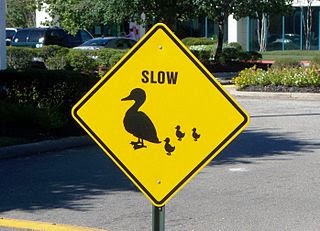May Day happens each year on 1st May and (per Wikipedia) is “an ancient Northern Hemisphere spring festival.” Leeds is a city with a number of road markings that read “XING AHEAD”.
 |
| Here is duck xing sign |
The XING connection is that it “looks Chinese” whereas the real thing is Tingxi Huo of CHOFN (website at www.chofn.com) who delivered a number of formidable thoughts on Trademarks In China.
And 1st May is what we Brits call a “commencement date” : there will be new trade mark rules in place in China just before INTA gathers in Hong Kong in May 2014 !
This small report concerns only four matters that were of particular interest :
1) Translation : Our speaker explained that translation into Chinese characters might be (a) conceptual – so the translation of APPLE (the business) equates to “apple” the fruit, or (b) phonetic – and ADIDAS was given as an example of this, or (c) mixed – so (it seems) STARBUCK combines the characters for STAR (concept)and BUCKS (phonetic). And you can change ! It appears that LEXUS until June 2004 relied on a “conceptual” name – but when Chinese people (even English-speaking Chinese people returning from long-term visits to Europe) failed to link the LEXUS brand with its “conceptual” name in Chinese characters – the company changed to LEXUS in “phonetic” characters. Additional to this were (a) comment on “non-official” names or “nicknames” being used by Chinese-speakers (and the desirability of the brand-owner registering these names as trade marks), and (b) the importance of translating into Chinese characters in relation to goods-for-sale not only the brand-name but also supporting materials (such as labels and manuals).
2) The ® symbol : In China, this means “Registered in China” and Chinese Customs Officers police both incoming and outgoing infringement (emphasis supplied). In consequence : (a) if you intend to export goods from (say) the UK to China (and you have a trade mark registered in the UK or EU so it’s your practice to attach the ® symbol) then remove (or change to TM) so as not to attract the attention of Customs when goods arrive at port-of-entry in China, and (b) if you intend to have goods manufactured in China but don’t have a trade mark registered in China for those goods, then wise counsel is to search (the Register in China) before going ahead with an order for manufacture (and, in any event, be sure not to attach ® to such goods manufactured in China !)
3) Time limits : China became a Member of the World Trade Organisation in 2001 and 1st May 2014 is the date when time limits come into force for dealing with Trade Mark Applications (and for appeals). For example, there will be a time limit of 9 months for dealing with a new Application and a time limit of 12 months for dealing with an Opposition. For the first of these – our speaker made reference to the International system – filing locally in China will attract the 9-month time limit whereas the International system brings with it a time limit of 18 months. For the second of these – “special circumstances” will justify an extension of 6 months (so we wait to see what “special circumstances” will justify dealing with an Opposition in 18 months rather than 12 months).
4) (State) Administration For Industry And Commerce : this entity has 500,000 employees and it has teeth ! If presented with “clear-cut evidence” it will act quickly and effectively. It will not provide a brand-owner with damages, but it will initiate investigates / issue orders to cease infringement / confiscate (and destroy) infringing goods and tools / impose (significant) fines.
I travelled away from Leeds and Walker Morris and Tingxi Huo grateful that I’d learned something of the “similarities” between our systems in the UK / EU and those that will be in place in China after 1st May 2014. Now for INTA !
No comments:
Post a Comment